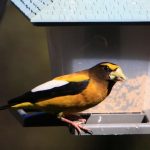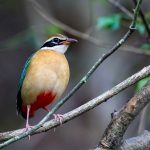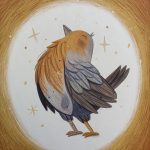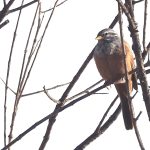If you’ve made it through winter in the company of a bevy of backyard birds, you’ll appreciate this next observation on avian identification.
Seed-eaters are easier to identify than meat-eaters.
Like you and me, most birds appreciate a good meal. In fact, a significant portion of a bird’s daily activity is devoted to seeking and savoring sustenance. If you stake out a source of food, chances are good you’ll find a few birds at supper; the more reliable the source, the more reliable the sighting.
A number of birds take their daily bread, so to speak, where they can. These opportunists are omnivores, hardly caring what foodstuff fills their bellies. Other birds are mostly or completely devoted to eating from either the animal or vegetable category. Carnivores may specialize in carrion, insects, fish, crustaceans, mammals, reptiles, amphibians, or even other birds, while herbivores may be partial to fruit, nectar, sap, or seeds. The differences between these two groups are myriad, but one dietary distinction worth noting is that for one group, dinner is on the hoof (wing, claw, what have you) while for the other, sustenance is stationary.
Herbivores are generally easier to identify than carnivores because they can be observed more carefully during their daily feeding routine. As sure as the sun will rise and set, a fruiting tree will attract fructivores. As constant as the passing of one season to the next, so are the flocks that will devour seed in the field. Watch the food and you’ll see the feeders.
Speaking of feeders, setting up bird feeders takes avian observation to a new, easier, and far more convenient level. Deploy the right array of treats and you’ll be able to enjoy amazing views of sparrows, finches, chickadees, nuthatches, doves, and blackbirds from the comfort of your own home. Slap up some suet and you’ll get woodpeckers and nuthatches too. What could be easier than identifying birds while at your kitchen table, cup of coffee in one hand and the Sibley Guide to Birds (full size, not field guide) in the other?
In any discussion of bird feeders, hummingbirds deserve special note. These iridescent imps can be tough to differentiate in the wild. If you live in a part of the world that offers more flavors than Ruby-throated, picking out a particular species buzzing through the trees is an enormous challenge. Nectar feeders and strategic gardening changes all that. A well-conceived backyard ecosystem might host nine or more exquisite species of hummingbird at any given time, birds that will light on the lip of a feeder long enough for conclusive identification. Try getting a flycatcher to do that for you!
Trips to the field will deliver ample opportunities to observe those species that dine on bug and beast. Waterfowl and waders abound everywhere fish swim and crustaceans crawl. But for the beginning birder, backyard bird feeders are invaluable oases of avian activity. Use these locales as training grounds for bird identification so you’ll be able to count on those skills when you meet the same species in the wild. Learn who eats what when and where and the whole intricate clockwork of ecology will unfold before you. Plus, you’ll see more birds!











Leave a Comment